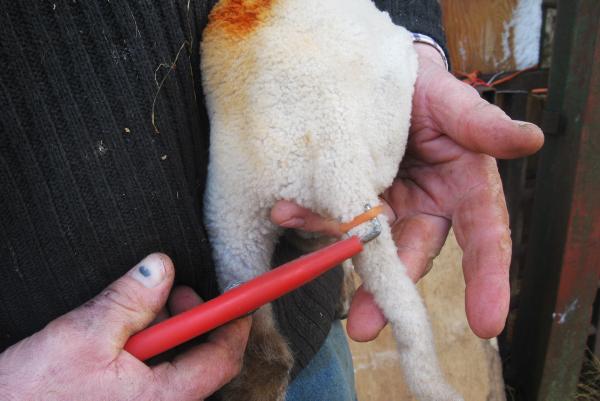My approach has always been to wring the tail off with my hands leaving a stump of about 5 cm (2 inches). This was done within the first week.
I pointed out to the inspector the animal welfare friendliness of this approach. The operation is completed in an instant. There is little or no bleeding. The lamb gets up and sucks from the ewe almost as if nothing had happened. Contrast this with the use of the rubber ring which leads to lambs rolling around on the ground in pain.
I could have added that hand wringing costs nothing but felt that the discussion was operating at a higher level than coarse commerce.
Anyway I was told that hand wringing of tails was not good practice in terms of the Quality Assurance and to desist from it. And to reinforce the point the inspector referred to the subject in his written report of the inspection.
Before rubber wrings arrived on the scene for de-tailing lambs, flockowners used to either wring the tails off by hand or cut them with a sharp knife. The number of lambs that reached “tailing” stage was taken as an estimate of the crop size as subsequent losses should be minimal. Again if it came to a choice between wringing and cutting tails I much prefer the former.
If you have the proper knack of wringing off tails the technique can be used on fully grown sheep. You split the wool on the tail, grab the tail stump in one hand. Use the other hand to give the tail a twist/flick. Off comes the tail. If done right there is very little loss of blood.
When it comes to tail removal and cruelty, what about an approach called “mulesling*” which I saw in Western Australia? If you want blood and gore this is your chance. One man held the lamb upside down while the other sliced off a large crescent shaped area of skin from around the tail. The idea is that no wool will grow on this area thus reducing the attraction for the blowfly.
However I cannot see this technique getting an Irish Quality Assurance blessing.
* Mulesling is called after a Mr Mules who developed the technique almost 100 years ago in Australia for Merino lambs.






 This is a subscriber-only article
This is a subscriber-only article












SHARING OPTIONS: